Field Trip "Art and Universe", October 16th/17th, 2024
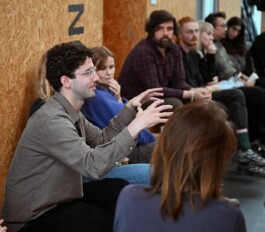

Date
October 16th/17th, 2024
Curiosity and the urge to explore, building on knowledge and discarding findings, adopting an attitude when dealing with contradictions and challenges: these are the driving forces that connect artistic research with the liberal sciences. And which we urgently need for the ecological transformation of a planetary population that is currently destroying its own livelihoods...
Nevertheless we know too little about each other and work together far too rarely. The rifts seem deeper than those of open-cast lignite mining, which from the perspective of outer space can be seen as a metaphor for the failed interaction of knowledge and will.

Hinrich Paulsen is Co-Founder & Senior Consultant at mundialis & terrestris.
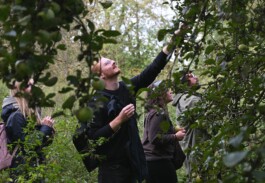
tree of knowledge?

Prof. Dr. Sascha Caron, Radboud University Nijmegen, reported on the latest developments in astroparticle physics and explained the Einstein Telescope.
October 16th
The gigantic intervention in the planetary surface left behind by Europe's largest opencast lignite mine in the Rhenish mining area is not just an eye-catcher for event tourists at the "Terra Nova" viewing point. The view into the crater is even possible from space, as satellite images show. Where small villages once created a home and fertile fields formed a granary of North Rhine-Westphalia, Germany's largest inland lake is to be created after the end of open-cast mining - filled with water from the Rhine. What's more, the mining region wants to transform itself from a climate polluter to a climate protector and become a model region for bio-based economies.
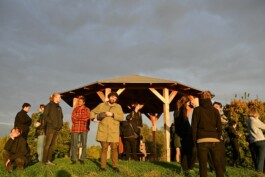
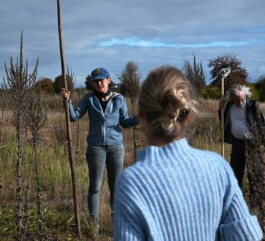
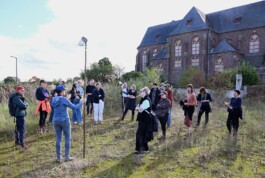
Host of the trip was the Cologne-based Findeisen Foundation, which recently brought the CUBITY ATELIERHAUS to Merzenich in the foothills of the Hambach open-cast mine. At this special location, we met Hinrich Paulsen (mundialis) and Sascha Caron (Nikhef), who gave us insights into innovative technologies for monitoring ecosystems as well as outlooks on extraterrestrial research projects and AI.
And how can knowledge enter the emotional cosmos of everyday people and pave the way for change? The sound snapshot of a wounded landscape (film by Frauke Berg & Oliver Gather) and our own exploration of the planetary environment provided a deeper understanding. A wetness walk introduced Loom, a Dutch artists' collective that uses experimental formats to unleash the transformative potential of people, places and organizations.
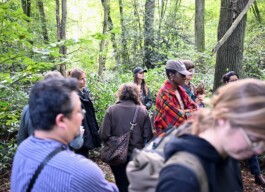

October 17th
The field trip ended with a walk through Manheim the next day: artist Silke Schatz lead us through the almost completely demolished village on the edge of the Hambach open-cast mine. Manheim's flora and fauna were able to partially recover on the resulting fallow land with its very good quality loess soil and now offer the opportunity to take a targeted look at the ruderal flora, the succession stages and overgrown former cultivated plants from meadows and gardens, among other things...
Thanks to the Findeisen Foundation for the great hospitality and especially to Sharon Nathan for the tight moderation through an intensive program!
Field Trip "Art and Universe", October 16th/17th, 2024


Date
October 16th/17th, 2024
Curiosity and the urge to explore, building on knowledge and discarding findings, adopting an attitude when dealing with contradictions and challenges: these are the driving forces that connect artistic research with the liberal sciences. And which we urgently need for the ecological transformation of a planetary population that is currently destroying its own livelihoods...
Nevertheless we know too little about each other and work together far too rarely. The rifts seem deeper than those of open-cast lignite mining, which from the perspective of outer space can be seen as a metaphor for the failed interaction of knowledge and will.

Hinrich Paulsen is Co-Founder & Senior Consultant at mundialis & terrestris.

tree of knowledge?

Prof. Dr. Sascha Caron, Radboud University Nijmegen, reported on the latest developments in astroparticle physics and explained the Einstein Telescope.
October 16th
The gigantic intervention in the planetary surface left behind by Europe's largest opencast lignite mine in the Rhenish mining area is not just an eye-catcher for event tourists at the "Terra Nova" viewing point. The view into the crater is even possible from space, as satellite images show. Where small villages once created a home and fertile fields formed a granary of North Rhine-Westphalia, Germany's largest inland lake is to be created after the end of open-cast mining - filled with water from the Rhine. What's more, the mining region wants to transform itself from a climate polluter to a climate protector and become a model region for bio-based economies.



Host of the trip was the Cologne-based Findeisen Foundation, which recently brought the CUBITY ATELIERHAUS to Merzenich in the foothills of the Hambach open-cast mine. At this special location, we met Hinrich Paulsen (mundialis) and Sascha Caron (Nikhef), who gave us insights into innovative technologies for monitoring ecosystems as well as outlooks on extraterrestrial research projects and AI.
And how can knowledge enter the emotional cosmos of everyday people and pave the way for change? The sound snapshot of a wounded landscape (film by Frauke Berg & Oliver Gather) and our own exploration of the planetary environment provided a deeper understanding. A wetness walk introduced Loom, a Dutch artists' collective that uses experimental formats to unleash the transformative potential of people, places and organizations.


October 17th
The field trip ended with a walk through Manheim the next day: artist Silke Schatz lead us through the almost completely demolished village on the edge of the Hambach open-cast mine. Manheim's flora and fauna were able to partially recover on the resulting fallow land with its very good quality loess soil and now offer the opportunity to take a targeted look at the ruderal flora, the succession stages and overgrown former cultivated plants from meadows and gardens, among other things...
Thanks to the Findeisen Foundation for the great hospitality and especially to Sharon Nathan for the tight moderation through an intensive program!